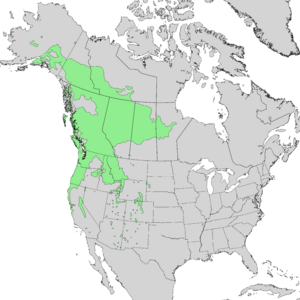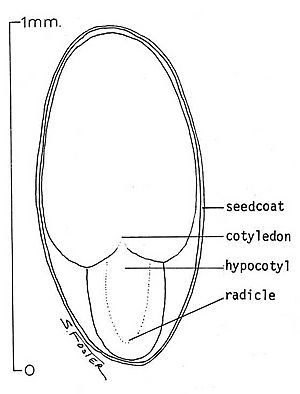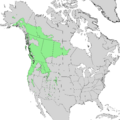Scouler's willow facts for kids
Quick facts for kids Scouler's willow |
|
|---|---|
 |
|
| Shrub with mature seed catkins | |
| Scientific classification | |
| Genus: |
Salix
|
| Species: |
scouleriana
|
 |
|
| Natural range of Salix scouleriana | |
The Scouler's willow (scientific name: Salix scouleriana) is a common type of willow plant. It can grow as a deciduous shrub or a small tree. You can find it across western North America.
This willow grows from south-central Alaska all the way east to Manitoba and the Black Hills of South Dakota. It also stretches south through the Rocky Mountains to Coahuila, Mexico. Along the coast, it grows through British Columbia, Washington, Oregon, and the Sierra Nevada in California. People sometimes call it fire willow, Nuttall willow, mountain willow, or black willow.
Contents
What Does Scouler's Willow Look Like?
Scouler's willow can be a shrub or a small tree. Its size depends on where it grows. In dry, cold, or high places, it usually has many stems and reaches 2 to 7 meters (about 6 to 23 feet) tall. In good growing spots, it can grow much taller, up to 10 to 20 meters (about 33 to 66 feet).
Its stems are straight with only a few branches. This gives the tree a narrow shape. The roots are strong and spread out deep into the ground. The wood inside is light-colored, almost white, with a reddish tint. The bark is thin and can be gray or dark brown.
Leaves and Flowers
The leaves of the Scouler's willow are shaped like a spoon, wider at the tip and narrower at the base. They are 5 to 12.5 centimeters (about 2 to 5 inches) long. The top side is dark green and smooth. The underside is white or grayish and feels a bit fuzzy.
This willow has separate male and female plants. This means you will find male flowers on one tree and female flowers on another. The tiny flowers grow in soft, furry clusters called pussy willow-like catkins. Male flowers have yellow parts that hold pollen. Female flowers have red parts that will become fruit.
After the flowers, the plant produces light reddish-brown fruits. These fruits are small capsules, about 0.75 centimeters (0.3 inches) long. When they are ready, they open up. They release tiny seeds attached to white, fluffy material. This fluff helps the seeds float away on the wind.
Where Does Scouler's Willow Grow?
Scouler's willow is the most common willow found in higher, drier areas. It grows very well after fires or when forests are cut down. Its seeds need bare soil to start growing.
You can find this willow in many different places. In northern areas, it grows in wet, spongy lands called muskegs. It also grows in willow thickets, disturbed areas, and forests. In warmer places, it likes areas that have been cleared, burned, or naturally disturbed. This includes places hit by avalanches or river floods.
These areas are usually moist, but the soil drains well. Even though this willow can handle drier conditions than most other willows, it does not like very dry, desert-like places. It can grow in almost any type of soil. It can be found from sea level up to about 3,000 meters (almost 10,000 feet) high.
How It Handles Fire and Shade
If a fire burns the top part of the plant, it usually grows back quickly. More than 65% of plants will sprout new growth after a fire. However, Scouler's willow does not like shade. If taller trees like conifers grow over it, the willow will start to die back.
Life Cycle and Reproduction

Scouler's willow flowers in the middle to late spring. The flowers often appear even before the leaves, sometimes when there is still snow on the ground. The fruits ripen from late spring to midsummer. Insects help to pollinate the flowers.
Each tiny seed is very light. There are about 14,300 clean seeds in just one gram! When seeds land on wet ground, they start to sprout very quickly. Germination, which means the seed starts to grow, can happen in just 12 to 24 hours. Most seeds will sprout within one or two days. The wind helps spread these seeds far and wide.
If a Scouler's willow plant is cut down or burned at the top, new shoots will grow from its base. Even pieces of its stem or root can grow into new plants if they are partly buried in moist soil.
Growing and Managing Scouler's Willow
New shoots from cut stems can grow very fast, about 1 to 3 meters (3 to 10 feet) taller each year. One cut stem can produce up to 60 new sprouts! These plants can reach about 9 meters (30 feet) tall in 20 years. In higher, colder places, they might reach 4 to 5 meters (13 to 16 feet) in 15 years.
If you want to collect seeds, you should pick the fruit by hand or with a long pole. Collect them as soon as they change from green to yellow. The capsules are then air-dried until they open. It is best to plant the seeds right away because they do not stay good for long. Seeds can be stored in a fridge for about four to six weeks, but they start to lose their ability to sprout after about 10 days.
Seeds should be scattered on well-prepared soil that is kept wet. They also need light to sprout successfully. For controlling soil erosion, it is suggested to plant rooted cuttings about 1.8 meters (6 feet) apart.
Why Scouler's Willow Is Important
Scouler's willow is very helpful for the environment. It protects the soil from washing away. It also helps forests grow back after disturbances like fires or logging. When it grows along streams, it keeps the stream banks strong. It also shades the water, which helps keep the water cool for fish and other animals.
This willow provides important cover for many animals, including mammals and birds. In early spring, its flowers give pollen and nectar to honey bees.
Food for Animals
Scouler's willow is a very important food source for both farm animals and wild animals. Cattle, sheep, and goats all eat its leaves and twigs. It is often a favorite food for white-tailed deer, black-tailed deer, mule deer, elk, moose, and bighorn sheep. Smaller animals, bears, and birds also eat its leaves, buds, and seeds. The fresh twigs and leaves are full of good nutrients like protein and minerals.
Uses by People
The wood of Scouler's willow is soft and fine-grained. It is not usually cut into lumber. However, it is sometimes used for firewood and for wood carving.
The Secwépemc people of British Columbia used the wood for smoking fish and drying meat. They also used it to build fishing weirs (traps for fish). The inner bark was used for tying things, sewing, making ropes, and headbands. They even made a special liquid from the twigs to treat skin problems like pimples and diaper rash.
Images for kids
-
Seed from Salix scouleriana
See also
 In Spanish: Salix scouleriana para niños
In Spanish: Salix scouleriana para niños




